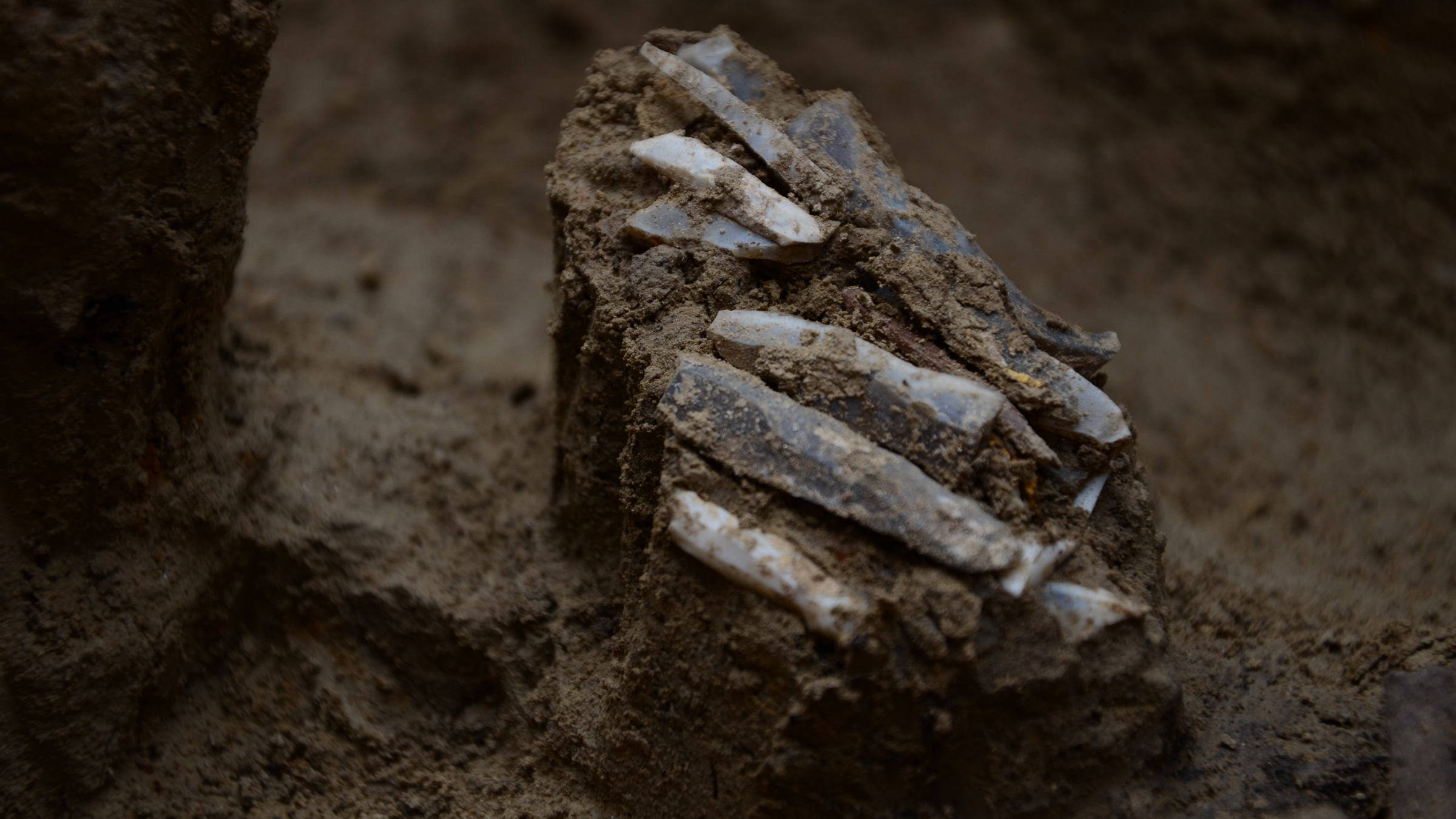30,000-year-old ‘personal toolkit’ found in the Czech Republic provides ‘very rare’ glimpse into the life of a Stone Age hunter-gatherer
By Aristos Georgiou
Copyright livescience

Skip to main content
Close main menu
Live Science
Sign up to our newsletter
View Profile
Search Live Science
Planet Earth
Archaeology
Physics & Math
Human Behavior
Science news
Life’s Little Mysteries
Science quizzes
Newsletters
Story archive
Man regains vision by tooth to eye implant
5,000-year-old stone tomb in Spain
Abandoning daylight saving time
JWST discovers possible black hole star
Million-year-old skull from China rewrites human origins
Don’t miss these
Human Evolution
Oldest wooden tools unearthed in East Asia show that ancient humans made planned trips to dig up edible plants
Archaeology
80,000-year-old stones in Uzbekistan may be the world’s oldest arrowheads — and they might have been made by Neanderthals
Archaeology
‘Extremely rare’ bronze armor found in Czech Republic dates to Trojan War era
Archaeology
‘Oddly shaped head’ left in Italian cave 12,500 years ago is Europe’s oldest known case of cranial modification, study finds
Human Evolution
2.6 million-year-old stone tools reveal ancient human relatives were ‘forward planning’ 600,000 years earlier than thought
Archaeology
See ‘hyperrealistic’ reconstructions of 2 Stone Age sisters who worked in brutal mine in the Czech Republic 6,000 years ago
Archaeology
Stone Age family may have been cannibalized for ‘ultimate elimination’ 5,600 years ago, study suggests
Human Evolution
1.5 million-year-old stone tools from mystery human relative discovered in Indonesia — they reached the region before our species even existed
Archaeology
2,200-year-old Celtic settlement discovered in Czech Republic — and it’s awash in gold and silver coins
Archaeology
5,000-year-old stone tomb discovered in Spain is 43 feet long — and it holds many prehistoric burials
Archaeology
2,200-year-old ‘complex and delicate’ Celtic warrior charm is evidence of sophisticated metalworking in the Iron Age
Archaeology
50 amazing facial reconstructions, from Stone Age shamans to King Tut
Archaeology
4,000-year-old human rib discovered high in the Pyrenees still has an arrowhead from a brutal attack
Archaeology
5,000-year-old burials in Germany hold 3 women with bedazzled baby carriers
Archaeology
An exotic quartz arrow may have killed a man 12,000 years ago in Vietnam
Archaeology
30,000-year-old ‘personal toolkit’ found in the Czech Republic provides ‘very rare’ glimpse into the life of a Stone Age hunter-gatherer
Aristos Georgiou
28 September 2025
Archaeologists have found an extraordinary cluster of Stone Age artifacts that may have been the personal gear of a single prehistoric individual.
When you purchase through links on our site, we may earn an affiliate commission. Here’s how it works.
The cluster of Paleolithic artifacts shown in their original context at the Milovice IV archaeological site in the Czech Republic.
(Image credit: Martin Novák)
Around 30,000 years ago, a hunter-gatherer left behind what may be a “personal toolkit” in what is now the Czech Republic, a new study finds.
Researchers uncovered the extraordinary cluster of artifacts in 2021 during an excavation at the Paleolithic site of Milovice IV. The “kit” contains 29 stone blades and bladelets that were found clumped together. The nature of the find indicates that the tools were bundled when deposited, likely in a container or case made from a perishable material, according to the study, which was published Aug. 13 in the Journal of Paleolithic Archaeology.
This rare collection is likely the personal gear of a prehistoric person who may have used the tool kit during hunting expeditions and migratory journeys, the authors suggested. But the individual, whose sex is unknown, eventually lost or intentionally discarded the gear at a residential camp, the research team said.
You may like
Oldest wooden tools unearthed in East Asia show that ancient humans made planned trips to dig up edible plants
80,000-year-old stones in Uzbekistan may be the world’s oldest arrowheads — and they might have been made by Neanderthals
‘Extremely rare’ bronze armor found in Czech Republic dates to Trojan War era
The find provides a remarkable glimpse into the life of a hunter-gatherer from the Paleolithic, which spans roughly 3.3 million years ago to just over 10,000 years ago.
The artifacts likely highlight an episode in the life of one person — which is “very rare” for the Paleolithic, study first author Dominik Chlachula, a researcher at the Institute of Archaeology of the Czech Academy of Sciences, told Live Science in an email.
Moreover, the discovery may shed light on the behavior of prehistoric people during migrations or hunting trips, which did not tend to leave behind many traces in the landscape and are therefore practically invisible to archaeologists, he said.
Stone Age site
The Milovice IV site where the artifacts were found displays evidence of human activity across thousands of years of the Upper Paleolithic. But the particular archaeological layer in which the cluster was recovered represents a “relatively narrow timespan” of human occupation between roughly 30,250 and 29,550 years ago, according to the study.
Sign up for the Live Science daily newsletter now
Get the world’s most fascinating discoveries delivered straight to your inbox.
Contact me with news and offers from other Future brandsReceive email from us on behalf of our trusted partners or sponsorsBy submitting your information you agree to the Terms & Conditions and Privacy Policy and are aged 16 or over.
Evidence from the layer indicates that Paleolithic humans may have used the site to camp, produce tools and butcher animals , among other activities. But it remains unclear whether such activities occurred during a single occupation or several successive episodes.
If the artifacts from the proposed hunter’s tool kit had been found separated, they would not have stood out from the other discarded or worn-out artifacts commonly found at the Milovice IV site. “It is the context which makes them interesting,” Chlachula said.
An analysis of the tools and their traces of wear revealed that they were used in a variety of ways. While a few show tentative evidence of use as projectiles, others were likely employed for cutting, scraping and drilling. The study suggests that the tools may have been used for activities such as processing meat, animal hides and wood, according to the study.
RELATED STORIES
—European hunter-gatherers boated to North Africa during Stone Age, ancient DNA suggests
—Europe’s last hunter-gatherers had sophisticated societies that helped them avoid inbreeding
—10,000-year-old burials from unknown hunter-gatherer group discovered in Brazil
“We can argue that the cluster is associated with tasks conducted on hunting expeditions, initial butchering of game and possibly the maintenance of weapons or exploitation of woody plant resources,” the authors wrote in the paper.
The latest finds are associated with the Gravettian prehistoric culture, which existed in Europe starting around 33,000 years ago, persisting in different variants for several thousand years. They were known for hunting mammoths, living with dogs, and likely using spear-throwers and bows.
“Their economy was based on hunting and gathering, but they developed complex cultural, technological and social behaviour with long-distance connections,” Chlachula said.
Stone Age quiz: What do you know about the Paleolithic, Mesolithic and Neolithic?
Aristos Georgiou
Social Links Navigation
Live Science Contributor
Aristos is a freelance science reporter who has previously worked for Newsweek, IBTimes UK and The World Weekly. He is particularly focused on archaeology and paleontology, although he has covered a wide variety of topics ranging from astronomy and mental health, to geology and the natural world. He holds a joint bachelor’s degree in English and history from the University of Nottingham, and a master’s from City St George’s, University of London.
You must confirm your public display name before commenting
Please logout and then login again, you will then be prompted to enter your display name.
Oldest wooden tools unearthed in East Asia show that ancient humans made planned trips to dig up edible plants
80,000-year-old stones in Uzbekistan may be the world’s oldest arrowheads — and they might have been made by Neanderthals
‘Extremely rare’ bronze armor found in Czech Republic dates to Trojan War era
‘Oddly shaped head’ left in Italian cave 12,500 years ago is Europe’s oldest known case of cranial modification, study finds
2.6 million-year-old stone tools reveal ancient human relatives were ‘forward planning’ 600,000 years earlier than thought
See ‘hyperrealistic’ reconstructions of 2 Stone Age sisters who worked in brutal mine in the Czech Republic 6,000 years ago
Latest in Archaeology
Science history: Rosetta stone is deciphered, opening a window into ancient Egyptian civilization — Sept. 27, 1822
‘Gold coins started appearing one after another’: 1,400-year-old hoard with money and jewelry unearthed near Sea of Galilee
Rare wampum beads discovered at 17th-century colony in Newfoundland
1 million-year-old skull from China holds clues to the origins of Neanderthals, Denisovans and humans
5,000-year-old stone tomb discovered in Spain is 43 feet long — and it holds many prehistoric burials
7-year-old Maya child had green jade ‘tooth gem,’ new study finds
Latest in News
30,000-year-old ‘personal toolkit’ found in the Czech Republic provides ‘very rare’ glimpse into the life of a Stone Age hunter-gatherer
Is acetaminophen safe in pregnancy? Here’s what the science says.
Mysterious cosmic explosion can’t be explained, scientists say
Science news this week: A breakthrough cure for Huntington’s disease and a fast-growing black hole that breaks physics
Amazon rainforest trees are resisting climate change by getting fatter from CO2 in the atmosphere
Scientists unveil world’s first quantum computer built with regular silicon chips
LATEST ARTICLES
James Webb Space Telescope reveals thick cosmic dust of Sagittarius B2, the most most enormous star-forming cloud in the Milky Way — Space photo of the week
Do figs really have dead wasps in them?
Why OpenAI’s solution to AI hallucinations would kill ChatGPT tomorrow
Researchers uncover hidden ingredients behind AI creativity
Science history: Rosetta stone is deciphered, opening a window into ancient Egyptian civilization — Sept. 27, 1822
Live Science is part of Future US Inc, an international media group and leading digital publisher. Visit our corporate site.
Contact Future’s experts
Terms and conditions
Privacy policy
Cookies policy
Accessibility Statement
Advertise with us
Web notifications
Editorial standards
How to pitch a story to us
Future US, Inc. Full 7th Floor, 130 West 42nd Street,
Please login or signup to comment
Please wait…



